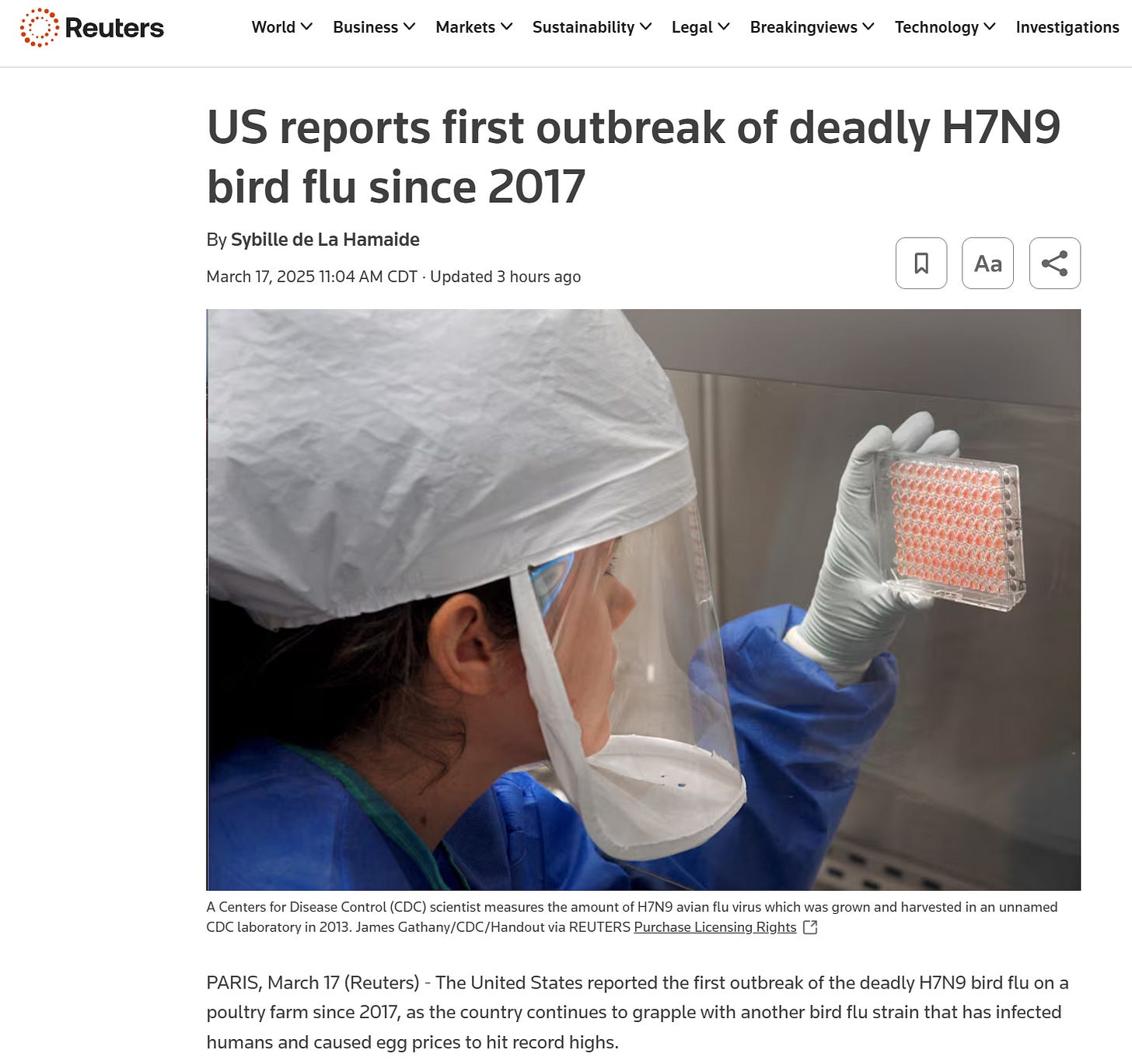The Evolving Threat of Bird Flu (H5N1 Avian Influenza): Lessons from Recent Outbreaks and Implications for Public Health Preparedness (2025)
Abstract:
The H5N1 avian influenza virus, historically a zoonotic pathogen with a high mortality rate, has re-emerged as a significant public health concern due to its recent adaptation to mammalian hosts, including dairy cattle and humans. This article reviews the progression of H5N1 outbreaks from 2022 to 2025, focusing on key developments such as the detection of genotype D1.1 in severe human cases and the potential for human-to-human transmission. Drawing from clinical observations and emerging literature, we evaluate current prevention strategies, including nasal sprays and highlight gaps in surveillance and response. We propose a multi-faceted approach to mitigate the risk of a pandemic, emphasizing enhanced zoonotic monitoring, worker safety, and public education.
Keywords: H5N1, avian influenza, bird flu, zoonotic transmission, public health, pandemic preparedness

Introduction
Avian influenza A(H5N1), commonly known as bird flu, has long been recognized as a pathogen with pandemic potential due to its high pathogenicity in humans (historically ~50% mortality rate) and widespread circulation in wild bird populations. Since its first notable human outbreak in Hong Kong in 1997, H5N1 has periodically caused sporadic human infections, typically linked to direct contact with infected poultry. However, recent developments—particularly since 2022—suggest a shift in its epidemiological profile. The virus has adapted to infect mammals, including dairy cattle and pigs, raising concerns about its potential to evolve into a strain capable of sustained human-to-human transmission.
This article synthesizes findings from recent outbreaks documented between 2022 and 2025, as reported in a series of updates from OneDayMD (covid19.onedaymd.com). We examine the implications of genotype D1.1’s emergence, the limitations of current containment strategies, and the role of novel therapeutic approaches in mitigating risk. Our analysis aims to inform public health strategies as the threat of H5N1 escalates.
Materials and Methods
Data were compiled from a series of articles published on OneDayMD between May 2022 and March 2025, focusing on H5N1 outbreaks, human cases, and expert commentary. Key sources include reports on the first U.S. human case in Colorado (May 2022), Dr. Peter McCullough’s insights on genotype D1.1 (March 2025), and updates on preventive protocols (e.g., FLCCC I-PREVENT, October 2024). Supplementary data were derived from cited references within these articles, including peer-reviewed studies (e.g., Hulscher & McCullough, 2024) and U.S. government reports (e.g., USDA, CDC). A qualitative synthesis was performed to assess trends in viral evolution, transmission dynamics, and public health responses. No primary data collection was conducted; all information reflects secondary analysis of existing reports.
Results
Epidemiological Trends
The H5N1 outbreak in the United States began gaining attention in April 2022 with the first confirmed human case in Colorado, linked to poultry culling. By March 2025, over 67 human cases had been reported, predominantly among dairy and poultry workers, with one fatality in Louisiana and a severe case in Canada associated with genotype D1.1. This genotype, distinct from the milder B3.13 strain circulating in cattle, has been linked to wild bird reservoirs and exhibits a higher severity in humans. Notably, a pig tested positive for H5N1 in late 2024, amplifying concerns about viral reassortment with seasonal influenza strains.
Viral Adaptation and Transmission
Evidence suggests H5N1 is adapting to mammalian hosts. The detection of D1.1 in dairy cattle in Nevada (January 2025) and its association with severe human illness indicate mutations enhancing mammalian tropism. Dr. Peter McCullough has warned of imminent human-to-human transmission, citing cases such as a critically ill 17-year-old in Canada and a toddler’s death in Southeast Asia following poultry exposure. While no sustained human transmission has been confirmed, the virus’s presence in respiratory secretions and unpasteurized milk underscores its potential for airborne spread.
Current Interventions
Preventive measures include nasal sprays (iodine vs. hypertonic saline) for frontline workers (Hulscher & McCullough, 2024). The CDC recommends avoiding exposure to infected animals, yet mass culling remains the primary containment strategy, a practice increasingly questioned for its efficacy. Antiviral medications (e.g., oseltamivir) have been used successfully in mild cases, but their role in severe D1.1 infections remains understudied.
Discussion
The progression of H5N1 from a bird-centric pathogen to one capable of infecting mammals and causing severe human disease reflects a critical juncture in its evolution. Genotype D1.1’s emergence, with its historical 50% mortality rate, contrasts sharply with the milder B3.13 strain, suggesting a dual-track epidemic with varying public health implications. The potential for reassortment in pigs—a known influenza mixing vessel—further elevates the pandemic risk.
Current responses reveal significant shortcomings. Mass culling, while reducing poultry infections, fails to address wild bird reservoirs or mammalian spread, as evidenced by ongoing dairy herd infections (over 900 herds by March 2025). Surveillance remains inadequate, particularly among asymptomatic or mild cases, which may obscure the true extent of human exposure. Occupational safety for farmworkers, often low-wage and under-protected, is a glaring gap, echoing lessons unlearned from the COVID-19 pandemic.
Novel interventions, such as nasal sprays, offer promise but lack rigorous clinical validation. The FLCCC’s I-PREVENT protocol, incorporating vitamin D and antiseptic mouthwashes, aligns with immune-boosting strategies but requires randomized trials to confirm efficacy against H5N1.
Conclusion
H5N1 avian influenza poses an escalating threat to global health, driven by its adaptation to mammalian hosts and the potential for human-to-human transmission. Current containment strategies are insufficient, necessitating a shift toward enhanced zoonotic surveillance, worker protections, and evidence-based therapeutics. As of March 23, 2025, the public health risk remains low but is poised to increase without proactive intervention. Future research should prioritize viral genomics, transmission dynamics, and scalable prevention measures to avert a potential pandemic.
Acknowledgments: The authors thank OneDayMD for providing open-access updates on H5N1 developments.
References:
- Hulscher, N., & McCullough, P. A. (2024). Routine iodine vs. hypertonic saline nasal sprays for H5N1 prevention in dairy and cattle frontline workers. The Focal Points.
- OneDayMD. (2022-2025). Bird Flu Updates. Available at: https://covid19.onedaymd.com/search/label/bird%20flu
- U.S. Centers for Disease Control and Prevention. (2025). H5 Bird Flu: Current Situation.

.png)
.png)




.png)

Comments
Post a Comment